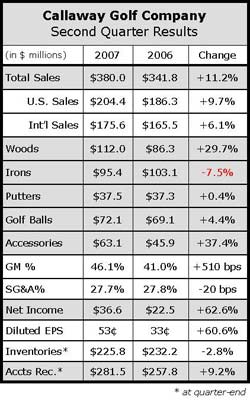Callaway Golf Company saw its margin initiatives continue  to pay off in the second quarter as net income growth well outpaced sales growth. A mix shift that saw a larger percentage of sales occur in Woods than Irons also helped boost margins and the bottom line growth, while the company sees an end to the supply issues that have plagued it since the launch of the FT-i driver on the horizon.
to pay off in the second quarter as net income growth well outpaced sales growth. A mix shift that saw a larger percentage of sales occur in Woods than Irons also helped boost margins and the bottom line growth, while the company sees an end to the supply issues that have plagued it since the launch of the FT-i driver on the horizon.
Management said that the double-digit quarterly sales growth was “primarily the result of strong sales of the Fusion FT-5 and FT-i drivers and X-20 irons.” Commenting on the supply problems, company CFO Brad Holiday said on a conference call with analysts that the company was “pretty well caught up on FT-5 by June,” but that demand continued to be strong for the FT-i causing the company to miss the end of June target. Holiday continued that “by the end of July, we had [the FT-i] almost all caught up with the exception of a couple of SKUs.” While Drivers were strong, the revenues brought in there were partly offset by a “slight decline in fairway woods and hybrids.”
Irons were the only product category to see a quarterly sales decrease for Callaway as a result of the introduction of the Fusion WideSole line in the year-ago quarter. This year, the company did not launch any new Irons product in Q2, instead launching the X-20 in Q1. CEO George Fellows noted that “sales for the first quarter increased 16%, and on a cumulative basis through the first six months, iron sales have increased 3% compared to last year.” Fellows also said that the X-20 line was the number one iron in U.S. revenue share for the year-to-date period through June.
In Putters, the company said it now holds a 40% U.S. market share, increasing 7 percentage points from the year-ago period. While sales in the category were relatively flat for the period, they are up 7% for the year-to-date.
The gain in Golf Balls came from “strong sales” of Callaway branded golf balls, as well as the new Top-Flite D2, which was said to have exceeded plan in terms of unit volume, putting the ball business on track to “make money for the first time in 2007.” In the second quarter, the companys overall Golf Ball business was described as profitable. Growth in the category was slowed by the culling of SKUs in the Top-Flite business; but, cutting back the line has also resulted in a 6 percentage point YTD increase in Top-Flite margins.
Like Golf Balls as a whole, the overall Top-Flite business was also a bottom line growth contributor in the quarter. Additionally, the company expanded distribution in the Green Grass Channel with nearly 800 incremental accounts in the U.S., once again, selling Top-Flite branded balls.
Europe drove the sales growth in international markets as the region saw revenues jump 29.4% to $70.3 million from $54.5 million in the year-ago quarter. On the call, management attributed the strength to poor weather last year compared to a strong start to this season, as well as the World Cup negatively affecting sales in the year-ago quarter. Canada and the South Pacific both were said to have seen “strong positive growth,” while sales in Japan slipped 0.6% to $33.8 million and Other Asia sales decreased 27.9% to $25.6 million. Fellows noted that “in local dollars, all regions had positive growth except Korea.”
Growth was described as “pretty much across the board” when looking at specific retail distribution channels. The Green Grass business was said to be “very solid,” with non-traditional golf retailers like Mass and Club merchants seeing a “positive response.”
While gross margins were well up over the year-ago quarter, they were actually down slightly compared to the first quarter, a result of an increase in irons sales. The X-20 line that launched in Q1 picked up steam in Q2, causing a sequential margin decrease due to the product mix shift.
On the bottom line, fully diluted EPS includes two cents of after-tax charges for gross margin improvement initiatives. The second quarter of 2006 had after-tax charges of a penny for the integration of Top-Flite and a penny for the restructuring initiatives announced in September 2005. Excluding these charges, ELY's pro forma fully diluted earnings per share for the second quarter of 2007 would have been 55 cents, an increase of 57% compared to 35 cents for the second quarter of 2006.
Looking ahead, ELY now expects full year sales to range from $1.07 billion to $1.08 billion, up from the previous estimate of $1.035 billion to $1.055 billion. Pro forma diluted earnings per share are new expected to be between 78 cents and 84 cents compared to the previous estimate of 72 cents to 82 cents.















